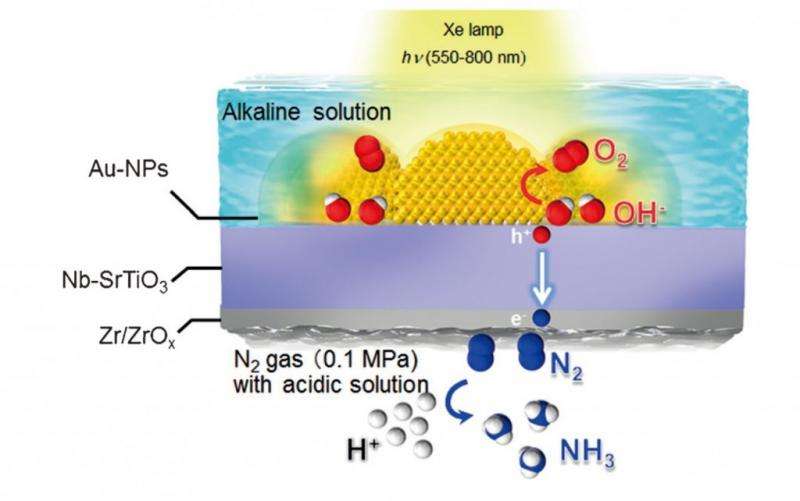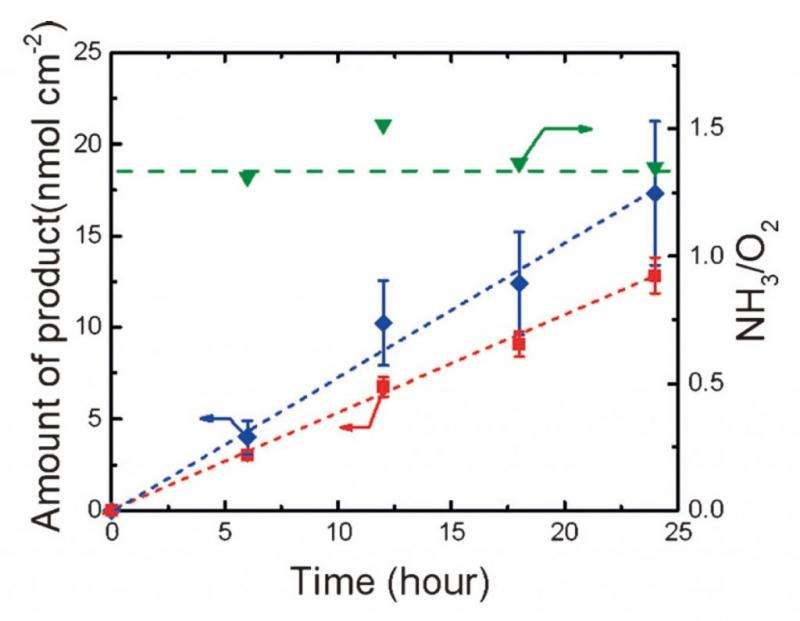Successful synthesis of ammonia using visible light, water, and atmospheric nitrogen

By using a photoelectrode in which gold nanoparticles are loaded on an oxide semiconductor substrate, a research at Hokkaido University, Japan, has worked to develop a method of artificial photosynthesis that has received attention as an ultimate light energy conversion system.
Ammonia has gained attention as a next-generation energy carrier. By combining an optical antenna structure that can concentrate light into a nano-space, and a co-catalyst that selectively adsorbs nitrogen, we have succeeded in selectively synthesizing ammonia from water and dinitrogen under visible light irradiation.
The synthesis of ammonia, which is a raw material for chemical fertilizers and chemical products, uses more than 1 percent of the energy consumption of the world for its synthesis. Therefore, this method of artificial photosynthesis that efficiently uses visible light can make a great contribution to energy savings on a global scale.
The research group of Professor Hiroaki Misawa and Assistant Professor Tomoya Oshikiri of the Research Institute for Electronic Science of Hokkaido University, by using a photoelectrode in which gold nanoparticles are loaded on an oxide semiconductor substrate, has worked to develop a method of artificial photosynthesis that has received attention as an ultimate light energy conversion system.

At this time this research group has developed a co-catalyst that can convert dinitrogen into ammonia with good efficiency, and by supporting this co-catalyst on a photoelectrode in which gold nanoparticles are loaded, they have succeeded in using water, dinitrogen, and visible light to selectively synthesize ammonia, which has gained attention as a next-generation energy carrier.
The research and development of artificial photosynthesis systems that convert solar energy into storable chemical energy have gained attention as a way to solve the global energy problem.
Ammonia is expected to be one of the next-generation energy carriers of chemical energy because it has little danger of combustion or explosion and can be liquefied relatively easily.
At the present time ammonia is commercially manufactured by the method called the Haber-Bosch process, but this reaction requires a large amount of energy, and more than 1 percent of the world's energy consumption goes into the Haber-Bosch process.
Accordingly, in order to efficiently use ammonia as an energy carrier, the world awaits the development of a low-energy synthesis method that is fundamentally different from conventional synthesis methods.
By combining an optical antenna structure that can concentrate light into a nano-space, and a co-catalyst that selectively adsorbs nitrogen, we have succeeded in synthesizing ammonia from nitrogen and water by using visible light, which is found in abundance in solar energy.
In the future, by improving the reaction efficiency and widening the response wavelength band, we will work towards the commercialization of this ultimate, clean "ammonia photosynthesis", which can generate ammonia from the visible light in sunlight, the nitrogen in the air, and water.
More information: Tomoya Oshikiri et al. Selective Dinitrogen Conversion to Ammonia Using Water and Visible Light through Plasmon-induced Charge Separation, Angewandte Chemie International Edition (2016). DOI: 10.1002/anie.201511189
Journal information: Angewandte Chemie International Edition
Provided by Hokkaido University


















